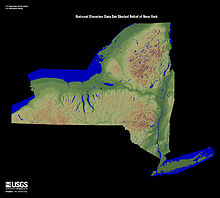Mohawk Valley region | |||
|---|---|---|---|
| |||
| Country | United States | ||
| State | New York | ||
| Major cities | |||
| Area | |||
| • Metro | 6,984 sq mi (18,088 km2) | ||
| Highest elevation at | 4,360 ft (1,330 m) | ||
| Lowest elevation at | −10 ft (−3 m) | ||
| • Density | 1,065/sq mi (411/km2) | ||
| Time zone | UTC−5 (Eastern) | ||
| • Summer (DST) | UTC−4 (PDT) | ||
| Part of a series on |
| Regions of New York |
|---|
 |



The Mohawk Valley region of the U.S. state of New York is the area surrounding the Mohawk River, sandwiched between the Adirondack Mountains and Catskill Mountains, northwest of the Capital District. As of the 2010 United States Census, the region's counties have a combined population of 622,133 people. In addition to the Mohawk River valley, the region contains portions of other major watersheds such as the Susquehanna River.
The region is a suburban and rural area surrounding the industrialized cities of Schenectady, Utica and Rome, along with other smaller commercial centers. The 5,882 square miles (15,230 km2) area is an important agricultural center and encompasses the heavily forested wilderness areas just to the north that are part of New York's Adirondack Park.
The Mohawk Valley is part of a natural passageway connecting the Atlantic Ocean, by way of the Hudson Valley, with the interior of North America. Native American Nations of the Iroquois Confederacy lived in the region. In the 17th century, Dutch, French and English immigrants —and in the 18th century German, Irish and Scottish—settled the area. Following the rapid industrialization of the mid-19th century, Italians and Welsh People settled in the valley.
During the 18th Century, the Mohawk Valley was a frontier of great political, military, and economic importance. Colonists— such as Phillip Schuyler, Nicholas Herkimer, William Johnson—trading with the Iroquois set the stage for commercial and military competition between European nations, leading to the French and Indian Wars and the American Revolution. Almost 100 battles of the American Revolution were fought in New York State, including the Battle of Oriskany, Battle of Saratoga and defense of Fort Stanwix. During the war, a series of raids against valley residents took place led by John Johnson. These raids were collectively known as the "Burning of the Valleys".
In 1825, the Erie Canal was completed as the first commercial connection between the American East and West.

